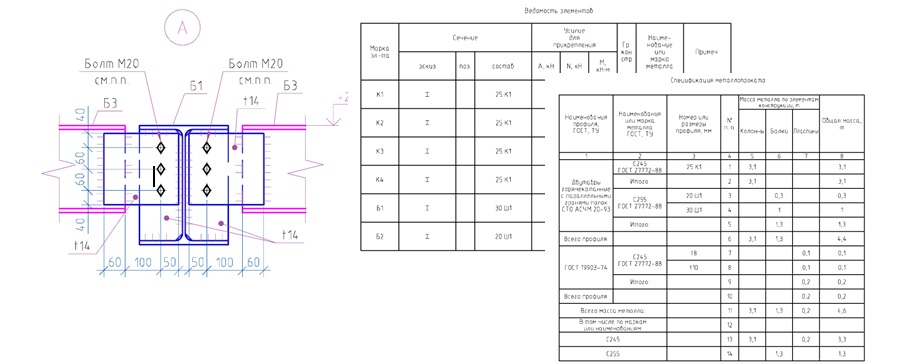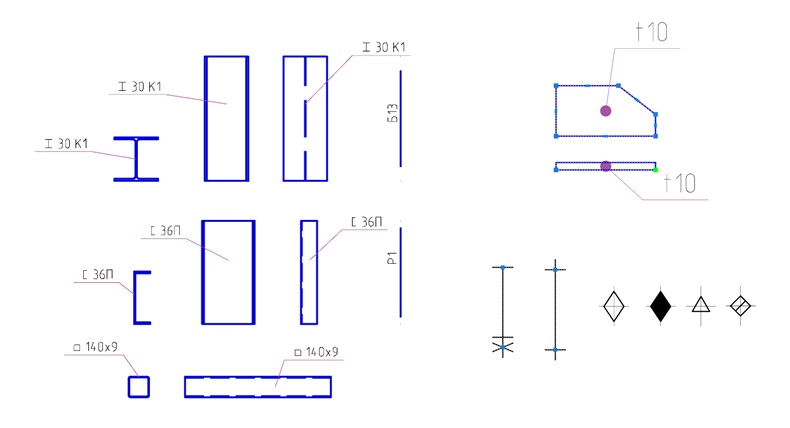Overview of the new features of nanoCAD SPDS Steelwork version 1.2
Last fall, Nanosoft JSC introduced the latest version of the vertical application nanoCAD SPDS Metal Structures 1.2, created for the development of two-dimensional drawings of metal structures of the KM brand. You can get acquainted with the functionality in detail in the product description nanoCAD SPDS Metal structures or in the article “ nanoCAD SPDS Metal structures. Full-fledged work on creating 2D drawings of the KM brand". The subject of this article is the new nanoCAD SPDS functionality of Metalwork version 1.2. When developing the new version, special attention was paid to the recommendations and wishes of users - at their request, changes were made to the work of the program tools. Significant improvements have also been made in the dynamics of the workflow - this is the new nanoCAD Plus 10 graphics platform with a new video driver and a new tape interface. As a result, in the new version, users will try modern and convenient program tools, experience a noticeable increase in the speed of processing drawings, saturated with parametric objects, texts, blocks, and other complex primitives.
But this is far from all, users are also provided with the whole set of necessary tools for drawing design, this is the built-in nanoCAD SPDS 9 functionality, unlimited creative freedom for the development of project documentation and, of course, the ability to finish work on a project on time.



First of all, I want to note the new tape interface, which provides modern standards for user interaction with the program. Tool icons nanoCAD Metal structures in the tape are informative and compactly located, this gives the user the most comfortable work with tools. But if you are used to working with the classic interface, you can quickly change it using the instant switch button.

To simplify and optimize the design, the program implements work with such parametric objects as a column, beam, plate. The user can select various metal profiles according to GOST standards, select the type of projection he needs (top, bottom, front, etc.), and also use special “handles” to edit the profile length or change the geometry of the plate.

As for the functional of the Project Manager, there have been dramatic changes in the direction of increasing the information content of the project. A new count Number of where those structural elements now appear to be included in the specification. In the column Namenotation icons have been changed. Now for each type of section of the profile has its own icon, which schematically displays this profile in the form of a section. These changes, of course, will help the user not only control the entire composition of the project, but also easily navigate in a wide variety of metal profiles.

Sooner or later, the user is faced with a problem such as the presence in the drawings of a significant number of elements of the same brand, which are repeated or even represented in other views or sections. It was quite problematic to sort out a huge number of identical brands, and even more so to know which brands should be included in the specification. This problem was successfully solved by the developers, and the new version of the program now has the opportunity directly from the Project Managerindicate which of the brands of the element should be included in the specification. For the convenience of work between the project manager and parametric objects, two-way communication is implemented, where the selected brand in the Project Manager automatically highlights this position in the drawing, which greatly facilitates the search for the elements that the user needs.

The beam / column dialog was also not neglected : on the View tab , the Main central axes switch was added . Now it’s not only fast, but convenient to set or remove the central axes for profiles.

For the case when the project is nearing completion and it is necessary to obtain the specification with the accuracy we need, it became possible to adjust the rounding of the metal mass. Now, when working with the specification of metal rolling, the user can configure for himself the necessary rounding parameters.

In conclusion, I would like to note that the nanoCAD SPDS Metalwork 1.2 program is a simple and convenient tool with extensive functionality that takes two-dimensional design to a new level. This software product allows today to significantly accelerate the release of design documentation for the KM brand and reduce the number of design errors.
nanoCAD SPDS Metalware 1.2 is compatible with 32 and 64-bit versions of Windows 10, Windows 8.1 and Windows 7. To work, you need a PC based on the Intel Core i3, i5 or i7 processor or the equivalent AMD Athlon processor. Discrete graphics card with support for OpenGL / DirectX-compatible hardware 3D acceleration and with a video memory size of 1024 MB or more. It is recommended to use the latest video drivers from the manufacturer of the video card and the latest versions of the OpenGL / DirectX libraries. You must have at least 2 GB of RAM and 1 GB of free space on your hard drive, mouse, and monitor with a resolution of at least 1024x768 or higher.
 Dmitry Gostev, Leading Engineer, Magma-Computer LLC
Dmitry Gostev, Leading Engineer, Magma-Computer LLC
But this is far from all, users are also provided with the whole set of necessary tools for drawing design, this is the built-in nanoCAD SPDS 9 functionality, unlimited creative freedom for the development of project documentation and, of course, the ability to finish work on a project on time.

The tasks that the nanoCAD SPDS Metal Structures program solves:
- Making drawings of plans, sections, nodes of metal structures;
- The ability to create various structural solutions of metal structures;
- Automatic formation of the sheet of elements and specifications of metal;
- Making drawings in accordance with GOST 21.502-20016 "Rules for the implementation of working documentation of metal structures."

Key advantages of the new version of nanoCAD SPDS Metalware:
- Fast and flexible tools for applying and editing elements of a metal frame;
- Automatic assignment of positions, brands and their display on the drawing;
- Fully automatic calculation and formation of specifications;
- Work in a nanoCAD environment using the built-in nanoCAD SPDS functionality.

Let's take a closer look at the main changes in the program
First of all, I want to note the new tape interface, which provides modern standards for user interaction with the program. Tool icons nanoCAD Metal structures in the tape are informative and compactly located, this gives the user the most comfortable work with tools. But if you are used to working with the classic interface, you can quickly change it using the instant switch button.

To simplify and optimize the design, the program implements work with such parametric objects as a column, beam, plate. The user can select various metal profiles according to GOST standards, select the type of projection he needs (top, bottom, front, etc.), and also use special “handles” to edit the profile length or change the geometry of the plate.

As for the functional of the Project Manager, there have been dramatic changes in the direction of increasing the information content of the project. A new count Number of where those structural elements now appear to be included in the specification. In the column Namenotation icons have been changed. Now for each type of section of the profile has its own icon, which schematically displays this profile in the form of a section. These changes, of course, will help the user not only control the entire composition of the project, but also easily navigate in a wide variety of metal profiles.

Sooner or later, the user is faced with a problem such as the presence in the drawings of a significant number of elements of the same brand, which are repeated or even represented in other views or sections. It was quite problematic to sort out a huge number of identical brands, and even more so to know which brands should be included in the specification. This problem was successfully solved by the developers, and the new version of the program now has the opportunity directly from the Project Managerindicate which of the brands of the element should be included in the specification. For the convenience of work between the project manager and parametric objects, two-way communication is implemented, where the selected brand in the Project Manager automatically highlights this position in the drawing, which greatly facilitates the search for the elements that the user needs.

The beam / column dialog was also not neglected : on the View tab , the Main central axes switch was added . Now it’s not only fast, but convenient to set or remove the central axes for profiles.

For the case when the project is nearing completion and it is necessary to obtain the specification with the accuracy we need, it became possible to adjust the rounding of the metal mass. Now, when working with the specification of metal rolling, the user can configure for himself the necessary rounding parameters.

In conclusion, I would like to note that the nanoCAD SPDS Metalwork 1.2 program is a simple and convenient tool with extensive functionality that takes two-dimensional design to a new level. This software product allows today to significantly accelerate the release of design documentation for the KM brand and reduce the number of design errors.
System requirements:
nanoCAD SPDS Metalware 1.2 is compatible with 32 and 64-bit versions of Windows 10, Windows 8.1 and Windows 7. To work, you need a PC based on the Intel Core i3, i5 or i7 processor or the equivalent AMD Athlon processor. Discrete graphics card with support for OpenGL / DirectX-compatible hardware 3D acceleration and with a video memory size of 1024 MB or more. It is recommended to use the latest video drivers from the manufacturer of the video card and the latest versions of the OpenGL / DirectX libraries. You must have at least 2 GB of RAM and 1 GB of free space on your hard drive, mouse, and monitor with a resolution of at least 1024x768 or higher.
 Dmitry Gostev, Leading Engineer, Magma-Computer LLC
Dmitry Gostev, Leading Engineer, Magma-Computer LLC